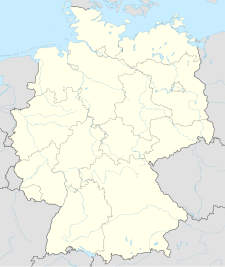Kemna concentration camp
| Kemna concentration camp | |
|---|---|
| Early concentration camp | |

Main building, ca. 1934
|
|
| Coordinates | 51°15′18.5″N 7°15′19.6″E / 51.255139°N 7.255444°ECoordinates: 51°15′18.5″N 7°15′19.6″E / 51.255139°N 7.255444°E |
| Other names | Wuppertal-Barmen concentration camp |
| Known for | torture |
| Location | Wuppertal, Germany |
| Operated by | SA |
| Original use | textile factory |
| Operational | July 5, 1933 – January 19, 1934 |
| Number of gas chambers | none |
| Inmates | political, religious, unionist |
| Number of inmates |
|
| Killed | unknown |
| Notable inmates | |
| Website |
www |
Kemna concentration camp (German: Konzentrationslager Kemna, KZ Kemna) was one of the early Nazi concentration camps, created by the Third Reich to incarcerate their political opponents (ostensibly in protective custody) after the Nazi Party first seized power in 1933. The camp was established in a former factory on the Wupper river in the Kemna neighborhood of the Barmen quarter of Wuppertal. It was run by the SA group in Düsseldorf.
The purpose of the early concentration camps was to repress and terrorize opponents of the new regime, primarily communists, but also socialists, dissenting Christians, and trade unionists. Unlike later concentration camps, the prisoners and the guards at Kemna were from the same cities and in many cases, knew each other and were already enemies from the German Revolution of 1918–1919 and subsequent political battles of the 1920s. Torture was practiced and the screams of the men were audible to people living and working nearby, and severely injured men were taken to nearby hospitals, all causing word of the camp's misdeeds to spread quickly. There was a major release of prisoners in October 1933; those released were forced to sign a document promising to keep secret all they had seen and experienced at the camp, and were threatened with re-arrest if they disobeyed. The Nazis wanted the public to become familiar with the term "concentration camp" and regard it with dread, but worried that the excesses at Kemna and the other early concentration camps would turn public opinion against them and thwart their plans. As a result, the camp was closed in January 1934, just six months after it opened. After the SA lost political influence, reports of torture led to an investigation and eventually to hearings and the perpetrators given a warning. No crimes were prosecuted.
...
Wikipedia

